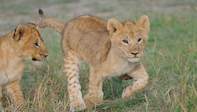
Every year thousands of people visit facilities in South Africa where they can interact with lion cubs and young cheetah But seldom do people ask what happens to the cubs when they grow too big for the facilities to manage them.
"There is substantial evidence to suggest that these animals are very often sold, or 'returned' to lion and other predator breeding facilities from which they are often sold on as trophies into the very lucrative canned hunting industry, which has thrived in South Africa for at least the past 12 years," says Yolan Friedmann, CEO of the Endangered Wildlife Trust (EWT).
With the inclusion of lions in the Threatened or Protected Species Regulations, the hunting of a captive bred lion within a period of less than 24 months post its release into an extensive wildlife area is now prohibited.
Cubs are often taken away from their mothers to stimulate faster reproduction and so keep up a constant supply of petting lions. Visitors pay to pet the animal and have their photograph taken with it, and either do not consider the animal's situation and what will happen to it when it grows up, or they assume that there is a conservation effort associated with petting lions.
Human Imprinted
The lions are however human imprinted and have not grown up in a natural social group, making it impossible to release them into a natural habitat for the long term. This, coupled with the disease risk posed by captive bred animals, as well as their dubious genetic lineage renders them a risk for release. They therefore have no conservation value and are purely a source of income for those exploiting them.
Often the situation of a "paying volunteer" is also exploited for further financial gain, with volunteers being told that the lion mothers are not able to care for their offspring and that once they are old enough hand raised lions are returned to the wild. A recent report by the National Council of SPCAs suggests that many of these lions end up as targets for canned hunting.The report states that "the hunting of captive bred lions is in fact at an all time high and the South African Predator Breeders Association (SAPBA) estimated in January this year that about 1 050 lions were hunted in South Africa in 2008. Nearly all of these animals were raised in captivity. This is a more than 300% increase on the 322 lions the Department of Environmental Affairs and Tourism (DEAT) says were hunted in 2006 and a 35% increase on their 2007 figure of 700."
This raises the question: where do all these lions come from? In South Africa, a thriving canned hunting industry can in most cases be linked to an equally thriving industry based on cub petting and commercial captive breeding centres.
Ask Questions
The EWT encourages the public to take an active role in putting an end to canned hunting by asking the following questions before taking an opportunity to play with a cub: Where is the cub's mother? Why is the cub not being raised by its mother? What happens to the facility's cubs when they grow up? If they are released into larger wildlife areas, where are these and can the facility provide documentation to prove a viable and ethical release process? If, and therefore once cubs have been released, do they have the opportunity to live out their natural lives, or are they hunted? If they are sold to game reserves, is their future secure or is this a cover for simply being hunted? If they become part of a breeding programme, for what purpose? What happens to the facility's surplus animals?Some may argue that there is educational value in allowing people to handle wild animals. However this kind of education provides the incorrect message that wild animals exist for human entertainment, that they can be petted like domestic animals, and that they have value only in captivity and not in their natural habitats. Moreover, lion cubs are naturally boisterous and even a young lion is capable of inflicting damage on a human being. Visitors are expected to sign indemnity forms that protect the facility, but many people are hurt, sometimes very badly, through these interactions.
It is also important to note that captive breeding is not a conservation recommendation for any carnivore species in South Africa. Carnivores in fact breed extremely well in the right conditions and for almost all our threatened carnivore species, the conservation priorities include reducing humanwildlife conflict, securing suitable habitat, reducing poaching and illegal offtake and maintaining balanced, functioning ecosystems. Without these in place, captive breeding leads to an over-supply of nonreleasable animals which often end up as trophies.
The Endangered Wildlife Trust is not against legal, ethical forms of sustainable use and recognises the role that hunting plays in many conservation programmes. We do not however support the intensive breeding of wild animals for canned hunting. It must be noted that other species are also hunted under condtions where they have no chance of escape and thus are also victims of canned hunting.
While we urge the government to address captive lion breeding situation in South Africa, and all canned hunting, we similarly urge members of the public to recognise their role in supporting or putting an end to both the cruel treatment of lions in some captive facilities, and the practise of canned lion hunting.
The EWT is working with many other NGOs to develop an ethical, humane proposal which may avert the continuance of cruelty being meted down to Africa's King of the Beasts.

